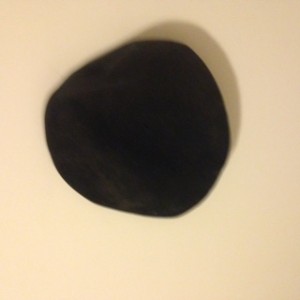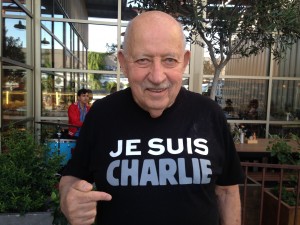I bought this Basque beret on my first trip to Paris in December 1947. It was the conventional garb of the French working class male adopted by intellectuals to demonstrate their solidarity with the working class. As an aspiring leftist intellectual, I coveted its symbolic association. For years, it was a prized possession which I wore both in Europe and America.
Arriving in London in September 1947, I was a graduate student studying art history. Granted that London was still recovering from World War II, it was a dreary place. For months, the city was bathed in rain, fog and smog. People were solemn and not demonstrative. They stared at me on the Underground because I looked different: my physiognomy and my clothes. The food consisted primarily of overcooked brussels sprouts and potatoes, spiced with Bovril, a salty meat extract. Until l stepped off the train in Paris in December, I had not seen the sun shine once. By contrast, Paris was sunny, ebullient with people eating, drinking, chatting and gesticulating at sidewalk cafés. I felt as though I had come back to life!
Sporting my beret and attempting to smoke a Gauloise, I would hang out at the Boulevard St. Germain Café de Flore, where it was reputed that Sartre and Simone de Beauvoir appeared regularly. Never saw them, but I was exposed to a lifestyle that I admired and have emulated and practiced for the rest of my life.
On my first trip to the Louvre, there was a handwritten sign tacked on the huge oak entrance door, “Attention à voleurs” (meaning pickpockets). I studied the collection assiduously. Many years later, I lead a group of New York City architects and planners to examine Paris as an evolving global city. We were given a tour of I.M. Pei’s yet-to-be completed renovation of the Louvre. A glass pyramid had replaced the eight-foot oak doors. When completed and open to the public, I returned many times.
The Rive Gauche was my center of gravity. On a subsequent trip to Paris in 1948, I met a girlfriend from London at a one star hotel off the Place St. Michel. It had a typical Parisian winding staircase and mirrors on the ceiling of certain rooms. Coming from Amsterdam, I was armed with a bouquet of tulips.
Within the Rive Gauche, there is an area called the Latin Quarter. There the Boulevard St. Michel, solid with bookstores, and the Boulevard St. Germain defined my turf. Neighboring cafés sand cheap restaurants abounded. At dinner in one of them, I complained to the garçon that there was a fly in my wineglass. He promptly stuck his fingers into my glass and extricated the demon.
At this time in my life, cheap was all that I could afford. On subsequent trips, I was exposed to better food at higherprices, but not exorbitant. I discovered Fauchon when they had one store near the Madeleine. Now, it is a global empire. My wife and I discovered HotPot a hole in the wall near the Odéon. We went there for a late lunch and developed a conversation with two women whose dogs sat beside them on their banquette.
Perhaps my most admired institution in Paris is the Centre Pompidou. I visited it for the first time in 1969 shortly after it opened. I loved their exhibitions and considered them to be extraordinary because they incorporated artistic and intellectual content. Subsequently, curators and a president of the Centre Pompidou became my friends.
My favorite exhibition was the 1986 Vienne 1880 – 1938 / L’Apocalypse Joyeuse. It was an incomparable encyclopedic zeitgeist exhibition dedicated to Vienna when it was in its prime incorporating great original works of art, art history, social and economic history with an overload of cultural documents. Enormously popular, it was decided to keep the Centre open until midnight. The first night, I was one of the thousands who assembled on the slopping esplanade that provides access to and egress from the building. The 2 1/4 inch wide Vienna exhibition catalogue proudly adorns my bookshelves. When there was a Jackson Pollock exhibition at the Centre, I was able to inform my New York photographer friend, Hans Namath, that his film of Pollock painting was projected above the entrance to the building. Secretly, I aspired to do an exhibition there. Prior to1989, I came up with an idea for a participatory media exhibition celebrating the 200th anniversary of the French Revolution. My attempts at selling the idea got nowhere because I was not French.
I was assigned by an American magazine to do a piece on the 20th Arrondissement, Edith Piaf’s neighborhood. Because I had done an exhibition and book about New York’s Lower East Side when it was an immigrant portal, I found striking similarities with different coefficients. The 20th (The last neighborhood to be incorporated into the City of Paris.) was multi-cultural as few neighborhoods were at that time. It had Algerians, Chinese, Central Africans and Moroccans, including a contingent of Jews, all living side-by-side. There were Catholic churches, synagogues and mosques. Its most prominent asset was the Père Lachaise cemetery. When there, I visited Jim Morison’s grave. I brought friends to eat at some of the 20th’s Chinese restaurants. While working on my article, I thought of staying in a neighborhood hotel, but was discouraged by a French friend.
Initially my launch pad, the Rive Gauche continued to be my locus – both high and low. From a one star hotel at the Place San MicheI I graduated to a three star hotel on the Place de Palais Bourbon. Sometimes, I would stay with friends who had an apartment on the rue de Varenne directly opposite Hȏtel Matignon, the Prime Minister’s residence. The Magnum Photos office at the Odéon served as a base for my professional pursuits in Paris and Italy. Its was located in the one of the passages about which Walter Benjamin wrote.
When my wife and I were attempting to practice the macrobiotic diet, I was overjoyed to learn that a macrobiotic restaurant had opened in the vicinity Notre Dame. Couldn’t wait to get there! Much to my chagrin, my dinner there was the worst meal I had in Paris. Some of my best meals were at aux petits oignons, a marvelous small restaurant in the shadow of the Musèe d’Orsay.
More like a small town or country restaurant, the owner was both chef and front of the house host.
Photo credit: Allon Schoener
All of these Parisian incidents, and many more, are woven into the pattern of my life and personality. As a graduate student, I studied art history in London and New Haven; however, Paris was my graduate school of life. Consequently, I am compelled to express my grief over the terrorist attacks that occurred on November 13, directed at what has become known as Génération Bataclan in which scores were killed and wounded by agents of ISIS.
The author, Allon Schoener
I am wearing a tee shirt produced by an international organization of journalists as a statement of solidarity with the victims of the January 2015 Paris attacks on the offices of the satirical magazine, Charlie Hebdo, and a Jewish supermarket. “Je suis Charlie” has become the symbol of freedom of speech whatever your beliefs, your country and your opinions
However, these events cannot be interpreted solely as the victimization of French citizens; they need to be equated with destructive events taking place in other parts of the world.
Footnote: For anyone reading this who has affection for Paris and similar experiences, I would encourage you to add them in Comments. I hope there are many. If so I will send them to a friend who is an assistant editor at Libération, the excellent left-wing daily. Since the first announcement of the ISIS attack on Paris, I have been reading Libé daily online.
Top image by Moyan Brenn, used under Creative Commons license. Color adjusted.



